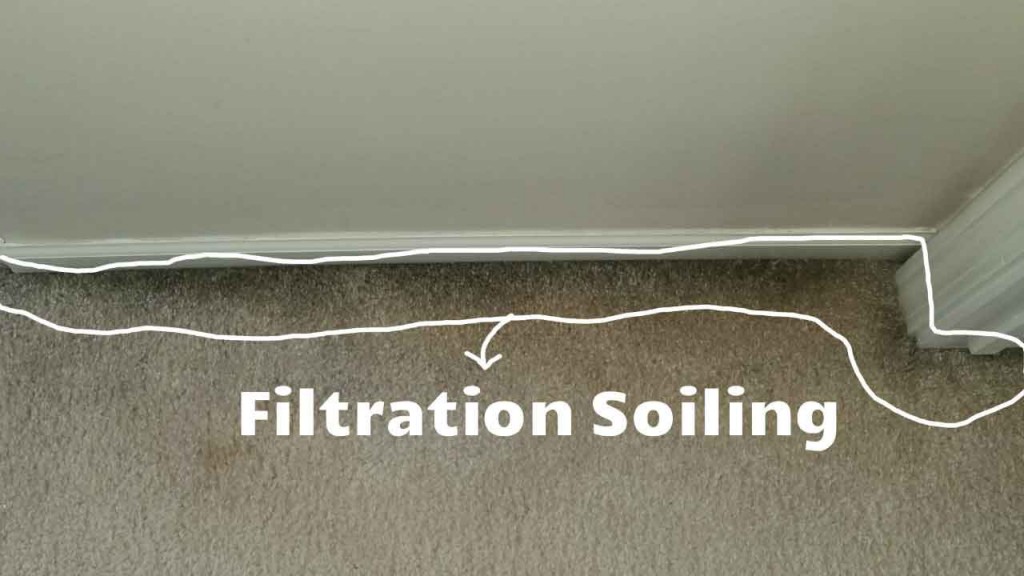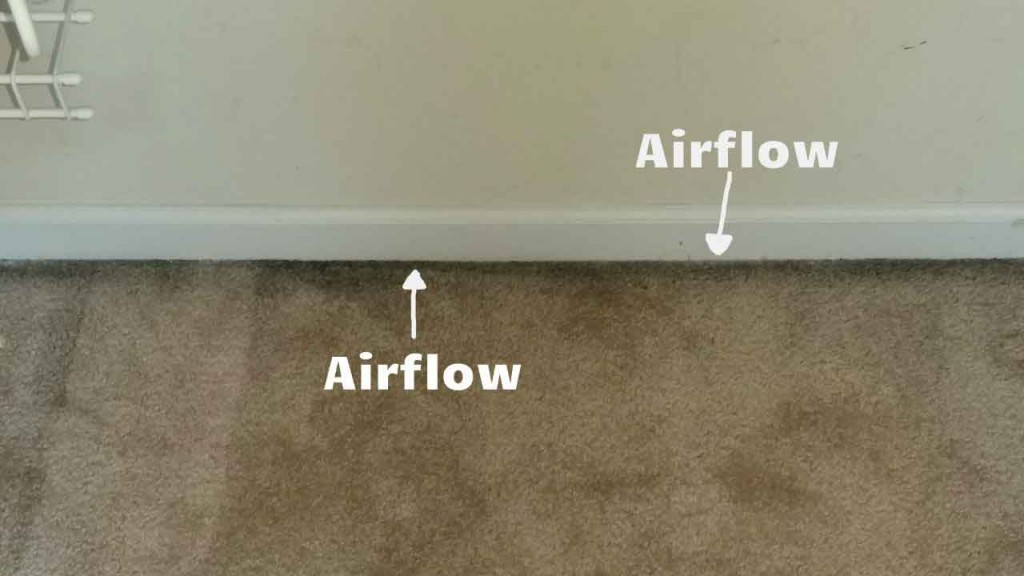What are those black streaks on my carpet?
One of our clients, Maria J.from Howell, asks:
“I have black streaks on the edge of my carpet. Is it mold? Is it from water? How did it get there and how do I get rid of it? Please help!”
We hear this question a lot, and as it turns out in most cases it’s not mold or water. It’s a condition called “Carbon Deposition” or “Filtration Soiling“. Here is what it is and what you can do about it.
Before continuing it’s important to note that while black streaks around the edge of your carpet most often indicate that it’s not mold or water, it is possible, although unlikely, that it could be either which is why it should be inspected first and not automatically assumed to be mold, water, or even filtration soiling.
 What is Filtration Soiling?
What is Filtration Soiling?
Every home and building “breathes”, meaning pressure changes cause the indoor air space to expand and contract. This expansion and contraction of air pressure in a building or home is caused by:
- Opening and closing doors and windows
- Outside air infiltration through building materials like studs, sill plates, and insulation
- Heater (forced air) or air conditioner turning on or off
- External temperature and pressure changes
And several other environmental factors.
When these air exchanges occur, the pressurized air seeks the path of least resistance, which is oftentimes the area where the floor meets the wall. When homes and buildings are built, the studs are nailed or screwed to the floor. Next, drywall or paneling is typically nailed or screwed to the wall. The drywall usually does not stretch the full height of the wall because it would be difficult for the contractor to fit the wall over the studs, so oftentimes there is a gap at the floor where the drywall or paneling is installed. When the wall is finished baseboards are installed, which cover over this gap. The last step is to install carpeting.
Now that you can visualize air pushing and pulling at the path of least resistance (the gap behind the baseboards where the drywall is above the floor) with pressure changes, you’re probably wondering why it’s black there. Enter: microscopic soil and soot.
What is microscopic soil and soot?
Every home and building has some degree and type of airborne particulates. We call this “microsoiling“. Using an air filter on your furnace helps to knock down the larger particulates, but some particles are so tiny that they can still slip through or around the filter. Indoor air filters can also assist, but the same principal applies: some microsoiling will make its way through or around the filter.
Where does microsoiling come from?
As mentioned, every structure has some degree and type of microsoiling. The most common types of microsoiling are caused by carbon deposits from:
- Burning candles
- Pilot lights – from the furnace, stove, hot water tank, or gas fireplace
- Cigarette and cigar smoke
- Oils released while cooking
- Burning logs in a traditional fireplace
- Vehicle exhaust from outside air introduced to indoor air
- Any type of flame combustion
 These microsoils mix with the indoor air and become pressurized and depressurized. This now-contaminated air always seeks equilibrium, meaning it seeks to find the path of least resistance, which is oftentimes right there where the carpet meets the baseboard. As the air travels across the carpet at the baseboard, the microsoiling is deposited on the carpet fibers which builds up and becomes more noticeable over time.
These microsoils mix with the indoor air and become pressurized and depressurized. This now-contaminated air always seeks equilibrium, meaning it seeks to find the path of least resistance, which is oftentimes right there where the carpet meets the baseboard. As the air travels across the carpet at the baseboard, the microsoiling is deposited on the carpet fibers which builds up and becomes more noticeable over time.
In other words filtration soiling doesn’t just happen overnight. It slowly accumulates and causes gray and then black lines to occur on the carpet at the edge of the baseboard.
How am I assured this filtration soiling is not water damage, or mold?
Firstly, you will want to inspect the area closely. Look for the following:
- Do the black streaks run the entire length of a wall or even the entire perimeter of a room? Filtration soiling often occurs around an entire perimeter of a room, and even under doorways, whereas water damage or mold usually only occurs at the source of water infiltration
- Do the black streaks vacuum up with an edging tool? If not, it could be filtration soiling
- When you get your carpeting cleaned, does it come out only to return later? If so, it’s definitely filtration soiling
How do I clean it?
It can be tricky or even impossible to clean it all off. Normal soil is much easier to clean than microsoil/filtration soiling for the simple fact that the particle size is much larger on normal soils. Filtration soiling particulates are so small that they can impart inside and between the structure of the carpet fibers themselves; even into the dye sites, which are the microscopic areas of a synthetic fiber that accept dyes.
And because microsoiling is mostly caused by carbon deposits it requires the use of high-pH products, aggressive agitation, or both, followed by extraction. The trick is to use the right products and proper agitation without damaging the carpet fibers, which is no easy task.
Can I prevent it from happening or recurring?
The simple answer is yes – filtration soiling can be prevented by taking the following steps:
- Have your carpet and upholstery cleaned at least once a year to cut down on microsoil buildup
- Try to eliminate the source, if possible. Burning certain candles greatly contributes to filtration soiling
- Have your HVAC, including furnace, hot water tank, and gas fireplace, checked and cleaned annually
- Change (or clean, if it’s the cleanable type) your furnace filter every 3-12 months, or as recommended by your HVAC service person
- Seal the gap behind the baseboard. This will require removing the baseboard, applying a bead of caulk where the subfloor meets the wall studs, and all the way up to the bottom of the drywall or paneling, and then reinstalling the baseboard after the caulk is dried. You can also use non-expanding inslating foam, but please be careful not to get the foam on the carpet or wall
Summary
You are now well-prepared to take on those ugly black streaks on the carpet edge, otherwise known as Filtration Soiling. As always, we are more than happy to answer your questions or help in any and every way possible. Our number is 810-225-2184.

- Should I get my new carpets professionally cleaned after construction? - January 8, 2019
- What is the Best Carpet Cleaning Method? - December 12, 2018
- How Often Should I Get My Carpets Cleaned? - October 30, 2018
Tags: black streak carpet, carbon deposition, carpet streaking, filtration soiling, microsoiling, soil fitration









